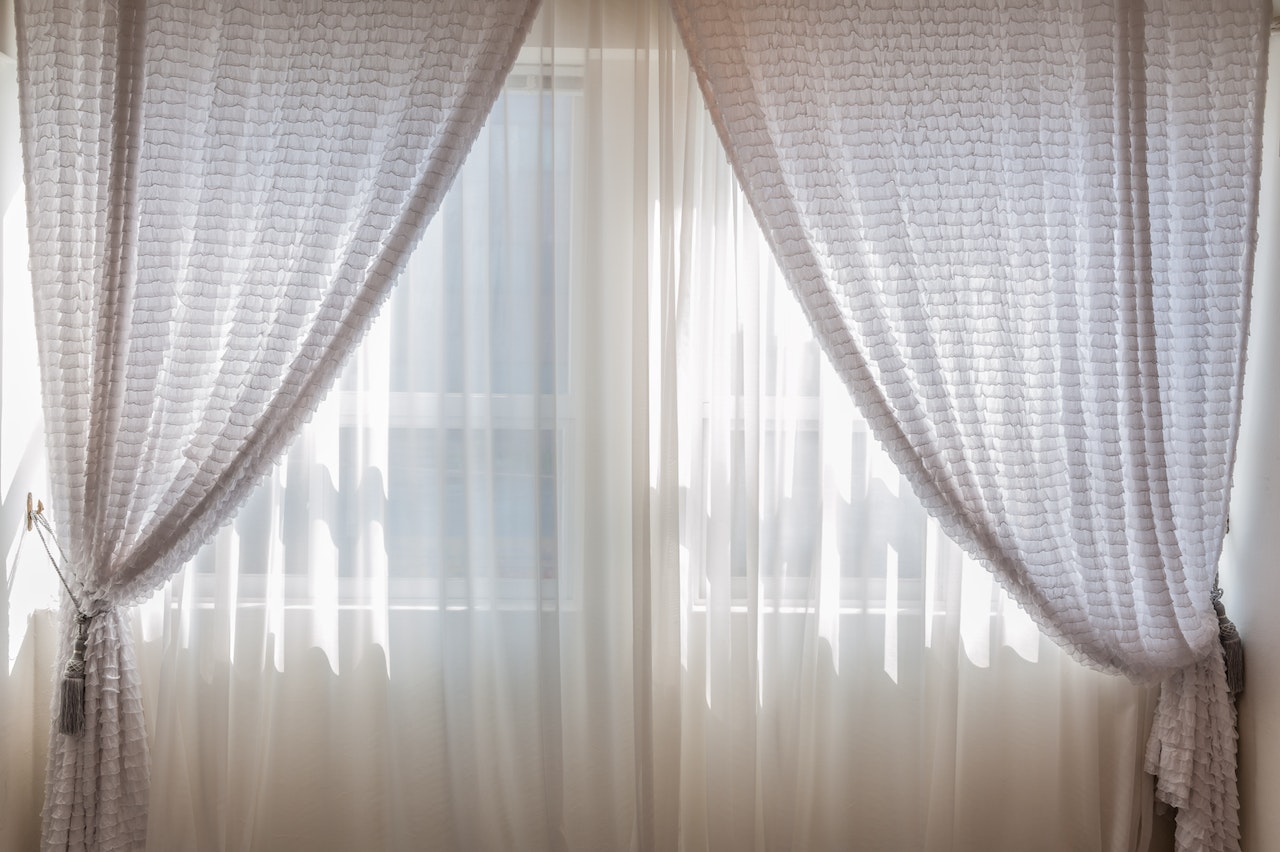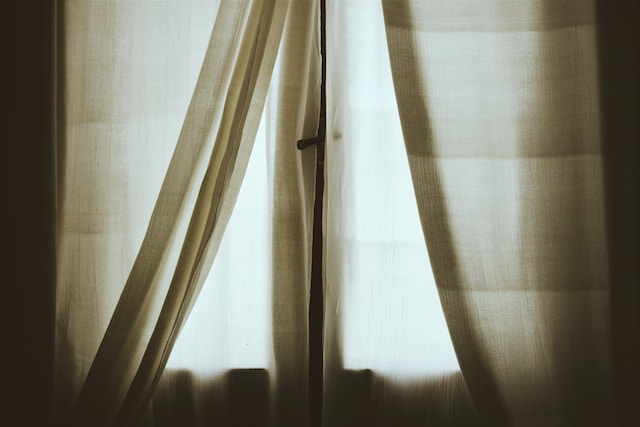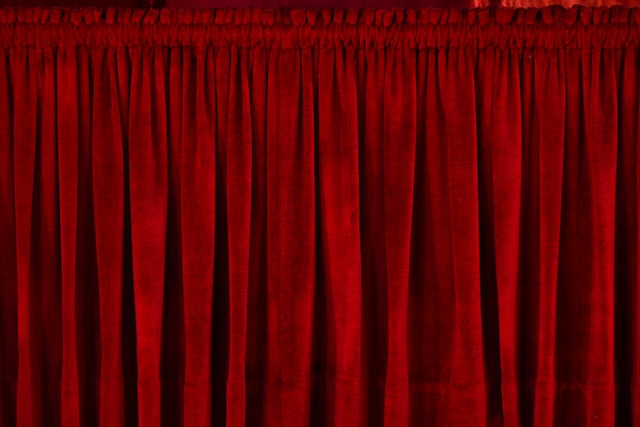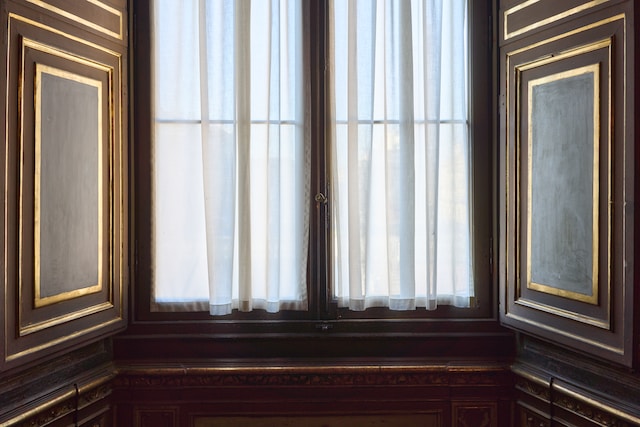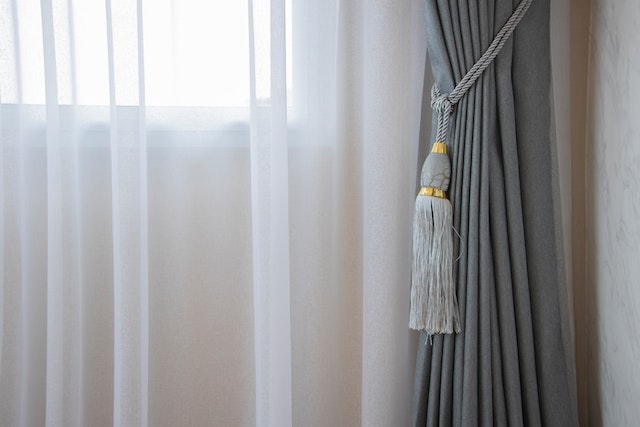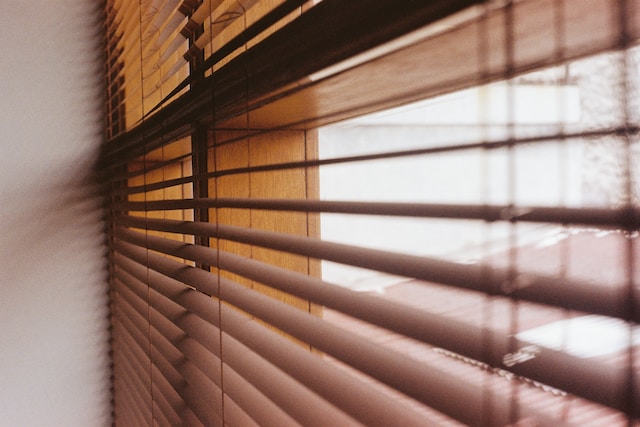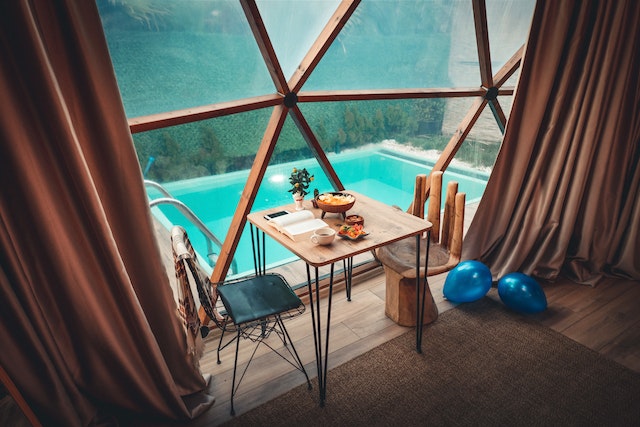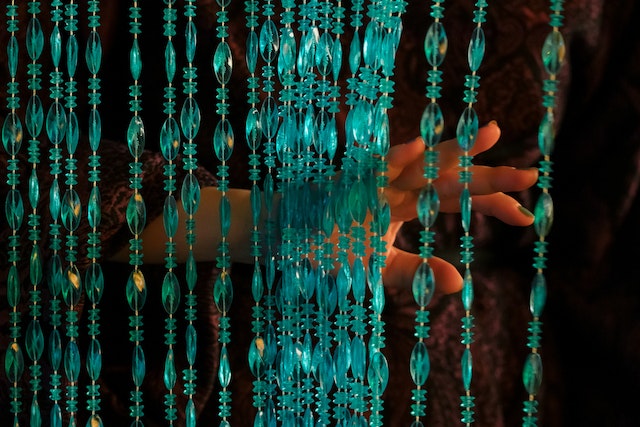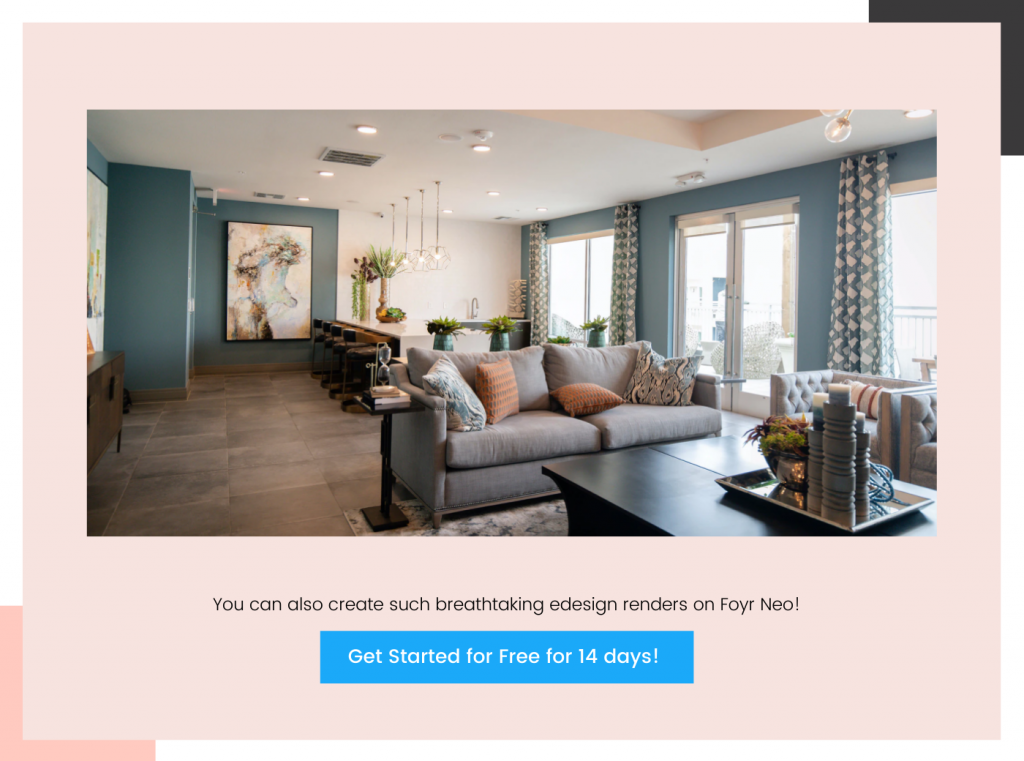Table of Contents
Curtains are lightweight fabrics designed to cover windows, while draperies are heavier, often lined materials that provide enhanced insulation and light control. Though selecting them might seem as simple as matching colors with the walls, studies by the U.S. Department of Energy (DOE) show that medium-colored drapes with white backings can reduce heat gain by up to 33% in summer and prevent up to 10% of heat loss in winter, making them an essential element for both aesthetics and energy efficiency.
Factors such as fabric thickness, curtain length, and placement significantly impact lighting, ambiance, and mood. Research by Cornell University found that natural light exposure can increase productivity by 23% and reduce eyestrain by 51%, making window treatments crucial for spaces like home offices.
Similarly, in bedrooms, optimal light control plays a key role in sleep quality, as studies from Harvard Medical School indicate that excessive artificial light at night can suppress melatonin production by up to 50%, disrupting sleep cycles.
With the help of interior design software – you can experiment with different curtain styles, fabrics, and placements to visualize how they affect natural light and the overall aesthetic of a space. Since a significant portion of daylight enters through the upper part of a window, selecting the right window treatments is essential for balancing light, privacy, and energy efficiency.
Walk with us as we explore how to choose the perfect curtains, what to expect, and how to select the right treatments for different rooms, whether it’s your living room, bedroom, kitchen, or nursery.
Assessing Client Needs for Curtains
The type and place your client wants to hang the curtains determines the properties the curtains will have, and it’s important to reverse engineer the process and start from what goals your client wants to meet.
The following are a few questions that can narrow down their choices and help you arrive at a suitable shortlist of options:
- Where will the curtain be hung?
- Do you want it to completely block out light or partially block light?
- Do you want a lined curtain?
- What fabrics feel right for your curtain choices?
- What types of curtains do you have in mind?
- How often can you wash or maintain them?
- Are you open to curtains that aren’t exactly made of fabrics? Would you be open to exploring them?
- What’s the home decor and color palette of the room these curtains will be used in?
- Do you want it to have insulating properties?
What are the Different Types of Curtains?
There are multiple types of curtains, depending on the materials, finishes, properties, and lining they have.
Lining
Linings stabilize the fabric keep sunlight from fading the fabric, and control light entry. It offers thermal insulation which protects from severe temperatures and sound insulation that keeps street noise away.
Interlined curtains
They have an extra layer of material between the lining and the main fabric. They are the thickest and heaviest curtain options to exist. Bedrooms would do well with interlined curtains. Another popular curtain material is the blackout curtain, which keeps the room dark and aids in quality sleep in the bedroom.
Unlined curtains
They have a single layer of fabric, look less formal and are absolutely budget-friendly. If your client only maintains curtains rarely, these curtains are perfect for them. The caveat is they don’t block out light, and the light is still going to enter the room. Unlined curtains are perfect for kitchens.
Tubelined curtains
The fabric and lining are joined together to form a tube-like structure, hence the name. They are best for smaller curtains. Please note that the curtain movement will be restricted for this type of curtain. If used as a living room curtain, it would be hard to move them to make way for bright light.
Sheer curtains
Lightweight, translucent, extra wide curtains that work well for wide windows.
Read also – How to Create the Best Architect Portfolio in 2024
Different types of curtain headings
Curtain headings are the top portion of the curtain where they meet the rod or pole. How they are hung decides how easy they are to move.
Tab top
The curtain fabric is used to form loops at the curtain heading and hung on a pole. It gives a modern and sleek look. But opening and closing the curtains are a major hassle, and there’s no smooth run.
Pencil pleat
The curtain heading looks as though a bunch of slim pencils are stacked together. The curtain fabric’s folds huddle at the curtain heading together to give a pleated look. It exudes a classic, refined look and works exceedingly well with any kind of fabric.
Eyelet
The curtain has defined eyelets, or small holes at the top, through which the curtain pole is fed. This type of curtain heading looks dashing and is trending right now.
The curtain heading is slightly folded inwards at the top and stitched together to create a channel. The curtain is slid underneath. In places where your client won’t ever move their curtains, pocket curtain heading is preferable.
Tempo
With an uneven shape at the top, they radiate a charming, informal, and contemporary aesthetic to the home.
Read also – 34 Beautiful Modern Kitchen Design Ideas for 2024
Different types of curtain lengths
Based on how far the curtain is from the floor, they are categorized into 4 types.
Sill length
These are curtains hanging half an inch above the window sill.
Apron length
These curtains hang 2-4 inches below the window sill.
Floor length
They stop ½ an inch above the floor.
Pooling
They are floor-length curtains extending 2-8 inches beyond the floor length to make way for a grand, palatial look.
Read also – 9 Best Contemporary Interior Design Ideas For Your Home
Different types of curtain hanging styles
Before we move on to the curtains, please note that the hanging pole or track must be 6 inches above the window and extend 6-8 inches on either side of the window.
Cased heading curtain
A sheer fabric curtain with an ombre effect, to put a bright spin on the traditional window treatment.
Hanging play tent
Directly suspended from the ceiling, can be closed or opened. They offer a secluded, dreamy space for solo activities, reading, writing, and sleeping for children predominantly. Hanging play tents can be installed in the nursery or the children’s room and adorned with bright colors, textures, and patterns.
Curtain tiebacks
Any curtain with a tieback (a tie, or a thick ribbon) to hold it away from the window, and maximize the entry of light into any space, especially the living room. Traditional buckram-lined tieback looks professional and tailored.
Lined eyelet
If your client doesn’t like a fussy window treatment and is looking for a contemporary, masculine look, this is a great choice. The tubelike folds require minimum fabric and look chic in any setting. If you have a metal pole, you can match the curtain’s finish to the eyelet rings.
Read also – How to Design and Decorate a Dining Room?
Shades and the role they play
If your client wants a refreshing, remarkable alternative to curtains, shades are a good option to consider. They use less fabric and yet create stunning effects. When trying out shades, ensure you guide your client through raising and lowering shades at different angles and assess their aesthetics and functionality at each angle.
Roller shade
The shade comes with a chain to raise and lower it. It’s primarily used for bathrooms and kitchens. These shades provide a level of privacy to a room and also heighten the cozy ambiance with a chic and contemporary look.
Roman shade
They automatically roll a fabric around the pole and the fabric stacks neatly as the shade is opened.
Tie shade
A panel of fabric rolled up and unrolled by tightening and loosening a pair of ties, that’s a tie shade. Contrasting ribbon ties and lining glam up the shade, which make for a stunning visual appeal in the living room.
London shade
It gathers only into soft folds when it is raised. It serves as an attractive focal point to the room it is in and is more casual in tone. No rods at the bottom.
Read also – 28 Best Wall Decor Ideas To Decorate Your Blank Wall
Draperies
They are window treatments that are constructed with heavy fabrics, keeping in mind the palatial, royal look the thick, block drapes display. They hang straight down from the ceiling, almost like the curtain.
Valance
It’s a drape that is closed at the curtain heading and at the end but is partially open in the middle to form a diamond shape. They are mostly lined have scalloped edges, and are held open by tassels, ties, or ribbons.
Swags
They are simple, long curtains that accrue wide folds at the top, near the curtain heading and suspend freely from the top all the way to the bottom. Swags are suitable for wide windows.
Curtain Panels
Super-thick, uniform, mildly patterned drape that is used mainly for decorative purposes, and blocks light.
Read also – What is 3D drawing and how is it transforming interior design?
Other types of curtain ideas
There are other interesting materials and types of curtains you can experiment with before finalizing the right fabric for each room if your client wants to add an extraordinary flair to their room decor.
Blinds
Blinds are simple to use, easy to clean, and of controllable height. They are found in both vertical and horizontal orientations, as rollers, and are commonly made from plastic, wood, faux wood, fabric, or metal.
Beads
Beads strung together to form a sequence that obscures vision beyond it. They show a free, contemporary feel with unlimited options. The beads can be acrylic, shells, bamboo, gemstones, glass beads, strong, and mirrors. They repel moisture and can be conveniently used in bathrooms with no fear of being dampened.
Voiles
Voiles are easily hung on the curtain pole. They are lightweight, easily washed, are of very low maintenance, and bring about a breath of freshness to the room with their artistic quality, and elegance.
Read also – How to Draw a Floor Plan & Top Mistakes to Avoid
Curtain materials to choose from
If you’re confused about what materials to select your client’s curtain from, here’s a set of commonly used fabrics for curtains, that can quicken your decision-making process.
| Material | Properties |
| Calico | Firm cotton curtains are user-friendly and can be easily bleached or unbleached. |
| Muslin | Lightweight, and white in color. Available in patterns as well. |
| Linen | Natural fiber, slightly heavyweight, and linen curtains come in neutral colors. |
| Jacquard | Comes in swirling patterns and foliage |
| Velvet | Soft to touch, but velvet can be one of the heavier fabrics to handle. |
| Chintz | High-quality cotton fabric with a breathable layer. |
| Gingham | Lightweight fabric often comes with small checkered patterns. |
How can I choose the right curtain design ideas?
With plenty of options available in every category, and one better than the other in many ways, showcasing all the options to your client and getting them to pick one is nearly impossible. You can do two things to ensure you select the right curtains for your client. Firstly, get to know them as a person, take a look at their wardrobe, what materials comfort them, what materials amaze them, and start from there. When you pose questions about their preferences and make observations about their liking in general, you will be able to ascertain the fabrics or types of curtains they’re drawn towards, present samples and seek feedback.
Secondly, and this is the best bet– you can use advanced interior design tools like Foyr Neo to conceptualize how their home will look, where window curtains will be designed, how light enters during different parts of the day, and how best to control overheating and glare at home.
Curtains not only control natural light from coming in, they also obscure your indoors to your neighbors in the evening, after sundown. So the materials, finishes, and colors you choose need to go well with natural and artificial illumination.
With Foyr Neo, you can’t make a mistake. You can draw up clearer-than-life floor plans, figure out light entry points, sight lines, and materials that would do well with the color palette, texture, and mood, select from 50,000+ 3D elements, follow AI-guided lighting and finishing touches and show your client multiple combinations of curtains and impress them in no time.
If you want to shorten your design process and also give the highest satisfaction to your client, Foyr Neo is the way to go.
Sign up for our 14-day free trial today, and start living your dream future.
FAQs
Measure the height from the curtain rod to the floor for length and consider 1.5 to 2 times the window width for width, ensuring that curtains extend beyond the window frame for an elegant look.
Custom-made curtains offer precise sizing, fabric choices, and unique designs to align with the home interior, while ready-made curtains are more cost-effective and convenient.
Install curtain rods or tracks close to the ceiling and extend the curtains well beyond the window’s width to create a sense of height and width.
Follow the manufacturer’s care instructions and regularly vacuum or dust curtains. Dry clean or wash them as recommended to maintain their appearance and durability.









